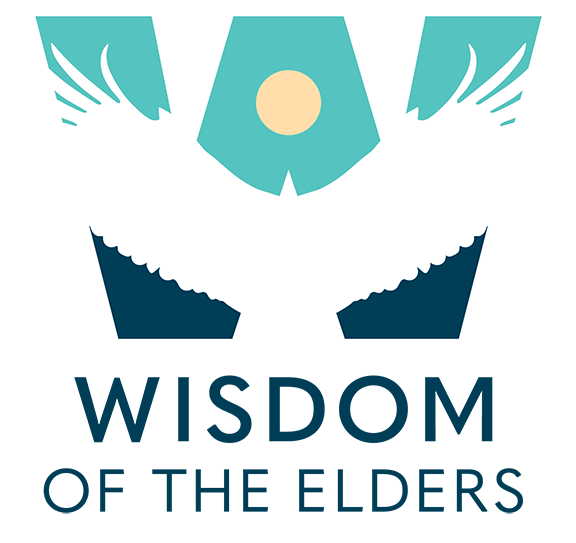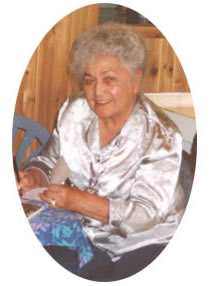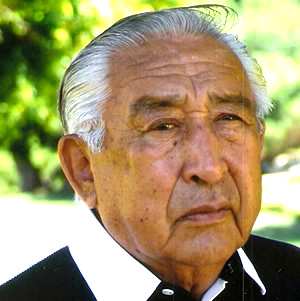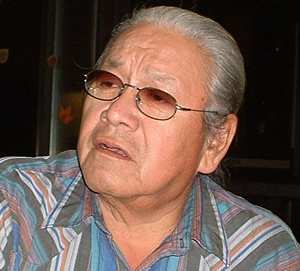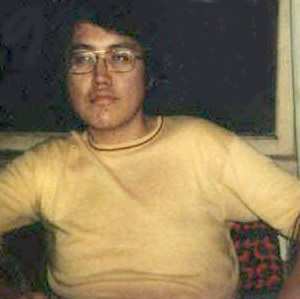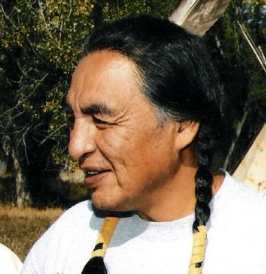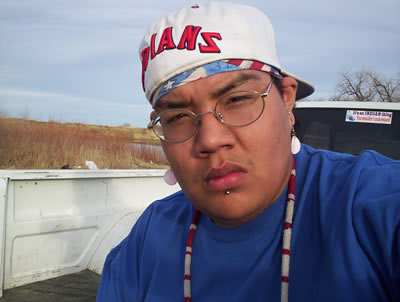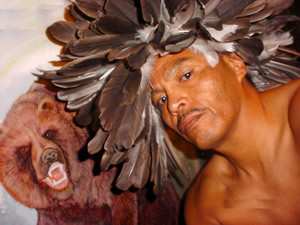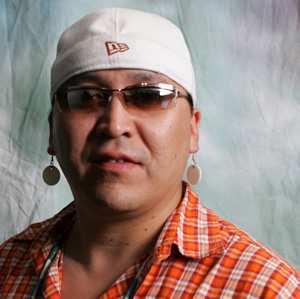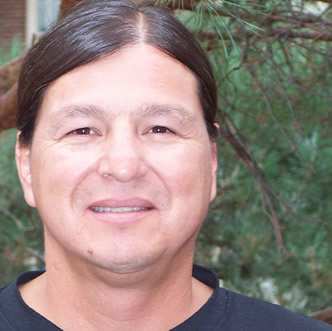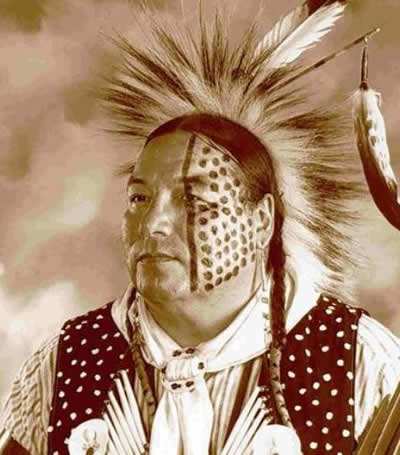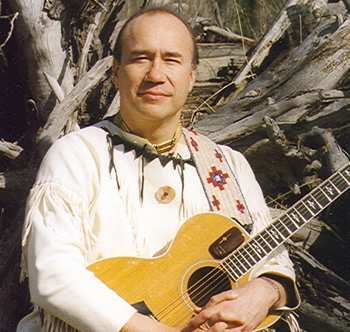Montana Storytellers
Alma Hogan Snell
Yellowtail, Montana, at the foothills of the Big Horn Mountains, is where tribal storyteller and ethnobotanist, Alma Hogan Snell, or Well Known Woman (Bea Azeta), lives today with her husband Bill. Her tribal affiliation is Crow. The tribe originally lived in Wyoming and Western Montana. Alma was raised by her grandmother, Pretty Shield, and her grandfather John Goes Ahead. She remembers learning to chop wood without an ax and spending many springs, summers, and falls roaming the surrounding foothills of Crow Agency with her grandmother digging roots, picking plants and berries. She watched her grandmother treat people with natural herbs and plants, which put her on the path to becoming an ethnobotanist. Her grandfather, John Goes Ahead, was one of the four main scouts for General Custer at the Battle of the Little Big Horn. He was also a very powerful medicine man. Pretty Shield was a Crow medicine woman.
Barney Old Coyote
“In the Oral-Experiential World of Native America, stories are the heart of tribal culture. At 78, Barney Old Coyote carries on that defining tradition. Some of the stories he shares were told to him by his grandmother, Medicine, and he has shaped and created others with his own pen and vision.” Excerpt from the magazine, Cowboys and Indians, January 2003, an article written by Jackie Bissley. Even though his interests run far and wide with education as a high priority, Barney’s storytelling continues as a signature feature in his many involvements, including but not limited to the following.
Robert Four Star
Robert Four Star is Red Bottom Assiniboine, or Nakona, from the Fort Peck Reservation, located west of Wolf Point, Montana. When Robert was born they gave him the name of Good War Paint. When they made him Chief of the Red Bottoms in 1981, they gave him the name of Buffalo Stops Four Times, which was the name of one of his great grandfathers. His great-great-grandfather was the first to carry the name Four Star. Robert’s mother is from the Little Rocky Mountain Assiniboines and also the People of the Mask from Moose Mountain in Saskatchewan. The name Assiniboine is an Ojibwa word that means “people who cook with stones.” There are traditional stories tying them to the Big River Assiniboines, the mound builder people, who lived east of St. Louis. They roamed in most parts of this North American continent from the tree line in Canada to the west coast to the open prairies. Smallpox devastated their population twice in the 1700’s and twice in the 1800’s. Today there are about 12,000 Assiniboines left.
Lewis Walks Over Ice
Lewis Walks Over Ice is a member of the Crow Tribe of Montana and resides in Lodgegrass. His mother’s family descends from Hawk With a Yellow Tail. Robert Yellow Tail, a former Crow tribal chairman, was the first Crow Indian to be superintendent of his own agency in the early 1930s, the first Crow Indian to graduate from high school, and the first to get a college degree. His Grandfather, Hillside, was second in command next to the chief of all chiefs, Plenty Coup when the Crow signed a friendship treaty with the United States. The Crow tribe originated in the Great Lakes area. They were pushed westward by the Sioux Nation and landed in present-day North Dakota. The original reservation covered 39 million acres and decreased in time to a little over one million acres. Today, tribal members own half the acreage and the other half is leased out to non-Indians such as farmers and ranchers.
Peter Bigstone
Peter Bigstone, HOKSHINA WASTE (good boy) is a full-blooded Assiniboine from the Ocean Man Reservation in Stoughton, Saskatchewan. Canada. Another name that was given to him at birth. Which is, WIYAGA YAMNI, (Three Feathers). Born and raised at the White Bear reservation. He grew up with his grandfather, Dick Nahbexie, GIYA DOBA HOKSHINA (Flying Four Boys) who taught him to share, teach and love the culture, spirituality, and language of his people. He is now one of about ten other people on Ocean man, who can fluently speak the Assiniboine (Nakoda) language. English is his second language. He is married by the old customary style/way of the Nakoda culture. Both he and his wife (Renita) reside in Harlem, Montana, and have five sons and four daughters. Five granddaughters and one grandson. (Many adopted children /grandchildren). Whom he had been teaching their tribal language and culture, like the grandfathers before him.
Dorrance Comes Last
Dorrance Comes Last, or Buffalo Boy (Tatankahokshina), is Sioux and Assiniboine and resides in Poplar, Montana on the Fort Peck Indian Reservation. Dorrance also has the nickname Bo Doo. He was raised by his grandparents, Clifford Young Bear, or Iron Gourd, and Vida Muskrat. This part of the reservation is considered the Badlands and is scattered with rivers and trees. The closest city is Billings, a three to four-hour drive.
Kenneth Lloyd Camel’s
Kenneth Lloyd Camel’s tribal affiliation is the Pend D Oreille tribe, this name is actually a French word meaning “Earring people,” “Ear-Drops,” and “Hanging Ears.” The name was given to them by the early traders that came through the area. When they first met nearly all wore large shell earrings. The shells were obtained from several sites: the Flathead lake, and Pend D’Oreille River, and formed an article of export. The tribe was also known as “Upper Pend D Oreille” in contradiction to the “Kalispel” who was sometimes called,” Lower Pend D Oreille.” The name for themselves was Ssc’lictcen used by the Kalispel and all the other tribes of the group. Ken prefers to be called a Pend D Oreille warrior for which he seeks guidance on his chosen journey. In 2000 he participated in the Jump Dance and requested the name Warhoop, which translates to C’o Si. The strong emphasis is on the “C” which is like the “Ch” in church. His name translates easily into Co Si Nemqmqey or War Hoop Camel. He currently lives on his “Peoples” reservation more formally referred to as the Confederated Salish and Kootenai Reservation. We adopted the Salish to include both the Upper & Lower Pend D Oreille tribes.
Roger White Jr.
Roger White Jr. is a member of the Red Bottom Band of the Assiniboine at Fort Peck Agency. The reservation is located in northeastern Montana between Big Muddy Creek and Big Porcupine Creek and extends from the Missouri River to the Canadian border. Descending from a long line of chiefs and warriors, his father, Chief Buffalo Stops Four Times, was one of the last chiefs of the Red Bottom People. His ancestors include Chief Big Mountain, He Wets His Arrows and medicine man, Chief White Dog, who had a reputation for his exploits on the warpath in Canada and as a capturer of horses. The Assiniboine occupied a vast region, following the buffalo that wintered in different areas from Wyoming north to Saskatoon, east to Minnesota, and west to the borders of Washington. Today, the terrain encompasses woodlands, plains, plush green rolling hills, and flat farmland.
Joe McGeshick
Historian and storyteller, Joseph Robert McGeshick, is an enrolled Sokaogon Chippewa (Ojibwa), his father’s tribe, and grew up on the Assiniboine and Sioux Reservation in Wolf Point, Montana, his mother’s reservation. Today he lives in Bozeman, Montana, and works at Montana State University-Bozeman in the Native American Studies Department. On his father’s side, Chippewa ancestors, Big Martin (kichiwabeshashi) and Big Eagle (kichimigizi) signed a number of treaties trying to save their traditional land, which caused the Sokaogon Chippewas to be landless for about 80 years until the 1930’s when they were given a reservation under the Indian Reorganization Act. They occupied the lake areas southeast of Lake Superior. There was deer hunting, wildlife, fishing, and wild rice. Wild rice was their mainstay. Rice Lake produced enormous amounts that helped keep them alive during the time that the tribe was not federally recognized. His mother’s side, the Assiniboine/Sioux, a buffalo, and horse culture, occupied the plains of northeastern Montana. The Assiniboine, which is actually a Chippewa term meaning “men who cook with stones,” called themselves Nakona. The Sioux called themselves Lakota or Dakota. The reservation in Fort Peck today has about 2 million acres of land.
Curley Youpee (Sung’ Gleska) Lakota Horse Dreamer
Lakota Horse Dreamer, Curley Youpee – Sung’Gleska, is a fifth-generation activist for Indigenous rights and environmental protection. He grew up on the Fort Peck Indian Reservation in northeast Montana. His approach to reducing racial hatred and social injustice against his people has earned him a seat in human rights circles and won him national recognition among US government organizations such as the Equal Employment Opportunity Commission, Bureau of Land Management, and Office of Federal Contract Compliance Programs. “It’s a matter of finding peace. Learning synergy through non-adversarial, action orient strategies,” declares Mr. Youpee.
Jack Gladstone
Jack Gladstone is an enrolled member of the Blackfeet Indian Reservation in northwestern Montana. He is a member of the Fisheater Clan of the Blood Band and currently lives between the Flathead Valley, the Flathead Reservation, and St. Mary’s Valley. Born in Seattle, Washington to a Montana Blackfeet father and a German American mother, Jack was a scholar and athlete in high school and grew up among the rich oral tradition of the American West. His great great grandfather, Red Crow, or ‘Me Kay Stow,’ was a legendary chief of the Blood Division. He was considered a great warrior and orator. William Gladstone, another grandfather of Jack’s, was a carpenter who helped build Montana’s Fort Benton and Alberta’s Fort Whoop-Up.
